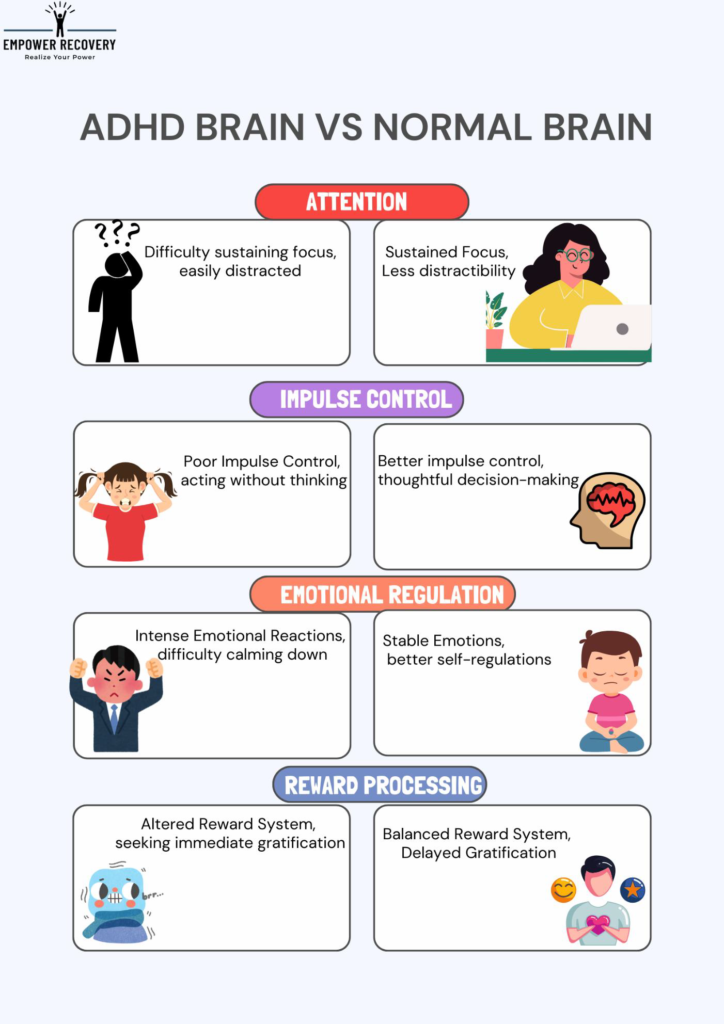Attention-Deficit/Hyperactivity Disorder (ADHD) is more than just a behavioural condition—it’s a neurodevelopmental disorder that affects the brain’s structure and function. Understanding the differences between an ADHD brain vs. normal brain can provide valuable insights into how ADHD impacts attention, impulsiveness, and hyperactivity. In this article, we’ll explore the key differences between an ADHD brain and a normal brain, including brain scans, dopamine levels, and brain activity.
ADHD Brain vs. A Brain Without ADHD: Structural Differences
Research using advanced imaging techniques like MRI has revealed several structural differences between an ADHD brain and a normal brain. These differences help explain why individuals with ADHD experience challenges with focus, impulse control, and emotional regulation.
Key Structural Differences:
| Brain Region | ADHD Brain | A Brain without ADHD |
| Prefrontal Cortex | Smaller in size, less active | Larger, more active |
| Basal Ganglia | Reduced volume | Normal volume |
| Cerebellum | Smaller, less developed | Fully developed |
| Corpus Callosum | Thinner, less efficient communication between hemispheres | Thicker, efficient communication |
Prefrontal Cortex: This area is responsible for executive functions like decision-making, attention, and impulse control. In an ADHD brain, the prefrontal cortex is often smaller and less active, leading to difficulties in these areas.
Basal Ganglia: This region helps regulate movement and behavior. Reduced volume in the ADHD brain can contribute to hyperactivity and impulsivity
Cerebellum: The cerebellum plays a role in coordination and attention. A smaller cerebellum in the ADHD brain may affect motor control and focus.
Corpus Callosum: This structure connects the brain’s hemispheres. A thinner corpus callosum in the ADHD brain can impair communication between brain regions.

Functional Differences Between ADHD Brain and A Brain Without ADHD
In addition to structural differences, the ADHD brain also functions differently compared to a normal brain. These functional differences are often visible in brain scans and can explain many of the symptoms associated with ADHD.
| Function | ADHD Brain | A Brain without ADHD |
| Attention | Difficulty sustaining focus, easily distracted | Sustained focus, less distractibility |
| Impulse Control | Poor impulse control, acting without thinking | Better impulse control, thoughtful decision-making |
| Emotional Regulation | Intense emotional reactions, difficulty calming down | Stable emotions, better self-regulation |
| Reward Processing | Altered reward system, seeking immediate gratification | Balanced reward system, delayed gratification |
Brain Activity: Studies using ADHD brain scans vs. normal brain scans show that the ADHD brain has lower activity in regions responsible for attention and impulse control.
Brain Waves: EEG studies reveal that individuals with ADHD often have slower brain waves (theta waves) in the prefrontal cortex, which can impair focus and decision-making.
ADHD Brain vs. A Brain Without ADHD: Dopamine Levels
Dopamine, a neurotransmitter that plays a key role in motivation and reward processing, is often imbalanced in the ADHD brain vs. normal brain.
Dopamine Differences:
| Aspect | ADHD Brain | A Brain without ADHD |
| Dopamine Production | Lower levels of dopamine | Normal dopamine levels |
| Dopamine Receptors | Fewer dopamine receptors | Reward Response |
| Emotional Regulation | Reduced sensitivity to rewards, leading to impulsive behavior | Balanced reward response, better self-control |
Dopamine and Motivation: Lower dopamine levels in the ADHD brain can make it harder to stay motivated and focused on tasks that don’t provide immediate rewards.
Medication Impact: Stimulant medications like Adderall work by increasing dopamine levels, helping to improve focus and reduce impulsivity.
ADHD Brain vs. Normal Brain in Adults
While ADHD is often diagnosed in childhood, it can persist in adulthood. The differences between an adult ADHD brain vs. a normal brain are like those in children but may manifest differently due to years of coping mechanisms and lifestyle changes.
Adult ADHD Brain Characteristics:
Prefrontal Cortex: Remains underactive, affecting executive functions like planning and organization.
Emotional Regulation: Adults with ADHD may struggle with mood swings and emotional outbursts.
Compensatory Strategies: Many adults develop strategies to manage symptoms, but these may not address the underlying brain differences.
ADHD Brain Scans vs. A Brain without ADHD Scans
Advanced imaging techniques like MRI and fMRI have provided valuable insights into the differences between an ADHD brain scan vs. a normal brain scan.
Key Findings from Brain Scans:
Reduced Gray Matter: The ADHD brain often has less grey matter in areas responsible for attention and impulse control.
Altered Connectivity: Brain scans show weaker connections between the prefrontal cortex and other brain regions in the ADHD brain.
Delayed Brain Maturation: The ADHD brain may mature more slowly, particularly in the prefrontal cortex.
Final Comments
The differences between an ADHD brain vs. a normal brain are significant and can impact every aspect of life. By understanding these differences, individuals with ADHD and their families can develop effective strategies for managing symptoms and improving daily functioning. If you or a loved one is struggling with ADHD, don’t hesitate to reach out to EMPOWER Recovery in Madison, Wisconsin. Together, we can empower you to take control of your life and thrive.




Pingback: ADHD in Teen Girls: Symptoms and Providing Support